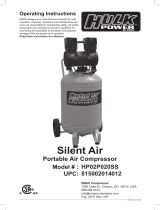
For multiple hazards, read and understand the safety instructions before installing,
operating, servicing, maintaining, changing accessories, or working near this tool.
Otherwise, it may cause serious bodily injury.
Only qualified and trained operators should install, adjust, or use this tool.
Do not modify this tool. Modifications may reduce the effectiveness of safety
measures and increase risks to the operator.
Do not discard the safety instructions; give them to the operator.
Do not use this tool if it is damaged.
Tools should be inspected periodically to verify that the qualifications and
markings required by this part of ISO 11148 are legibly marked on the tool. The
employee/user must contact the manufacturer to obtain replacement marking
labels when necessary.
6
AIR COMPRESSORS
GENERAL SECURITY
TOOL SAFETY
Mains plugs must match the outlet - Never modify the plug in any way. Do not
use adapter plugs with grounded power tools. Unmodified plugs and matching
outlets will reduce the risk of electric shock.
If using a power tool outdoors, use a Residual Current Device (RCD) - Make
sure the switch is in the "off" position when plugging into an outlet or inserting a
battery pack, or when lifting or carry the tool.
NOTE: The term "residual current device (RCD)" may be replaced by the term "ground
fault circuit interrupter (GFCI)" or "earth leakage circuit interrupter (ELCB)".
WARNING: Before connecting a tool to a power source (receptacle, outlet, etc.), make
sure that the supply voltage is the same as that specified for the tool, it can cause
serious injury to the user and damage to the property. tool. If in doubt, do not connect
the tool. Using a power supply with a voltage lower than the nameplate rating is
detrimental to the motor.
WARNING: This product is not intended for use by persons (including children) with
reduced mental or physical capabilities, or lack of experience and knowledge, unless
they have been given supervision or instruction concerning use of the appliance by a
person responsible for their safety. Children must be supervised to ensure that they do
not play with the appliance.
22.
23.
-
-
-
-
-
-






















